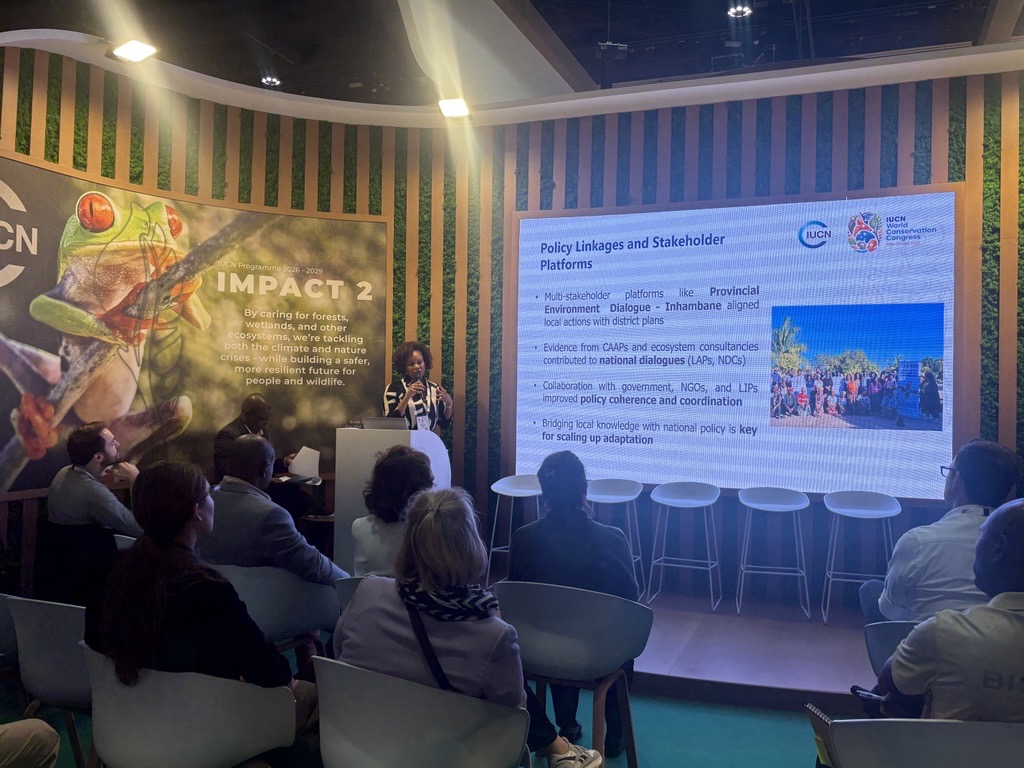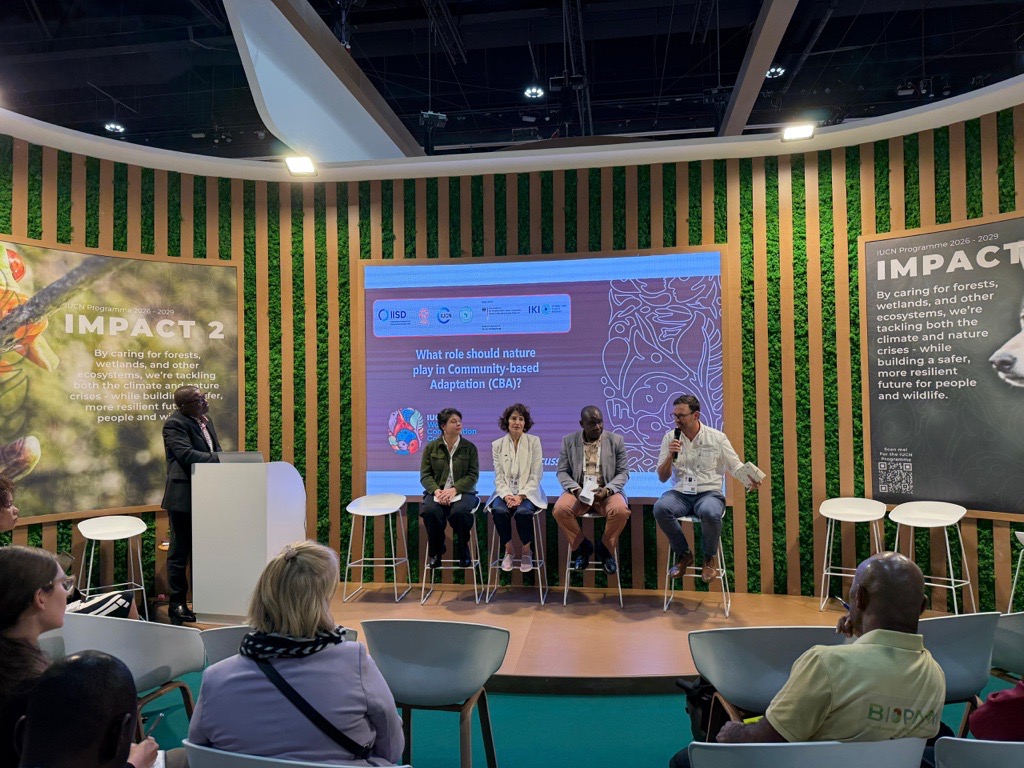IUCN World Conservation Congress | Abu Dhabi, UAE | 13 October 2025
Building on experiences from Zimbabwe, Zambia, and Mozambique, as well as Jordan, Syria and Lebanon, the session highlighted how Community-Based Adaptation (CBA) – when grounded in nature – can bridge the gap between local realities and global ambitions.
Setting the Scene: Local Leadership, Global Learning
Mr. Julio João, Provincial Director of Agriculture and Fisheries in Inhambane, opened the session by emphasizing the importance of building on communities’ existing responses to climate shocks. His remarks set the tone for a discussion centred on local leadership and knowledge.
IUCN Mozambique’s Carla Manjate Rombe then presented an overview of the CBAScale+ project, emphasizing that CBA is most effective when co-designed with communities and anchored in inclusive processes. Participatory tools such as Participatory Climate Vulnerability Assessments (PCVAs), Community Adaptation Action Plans (CAAPs), and Participatory Scenario Planning (PSPs) were cited as examples that build ownership, trust, and legitimacy.

Nature as the Foundation for Adaptation and Resilience
The first round of discussions, moderated by IUCN Zimbabwe’s Simba Mandota, explored how Ecosystem-based Adaptation (EbA) can strengthen the CBA approach by building local climate resilience while delivering biodiversity co-benefits.
Alec Crawford (Director of Nature, the International Institute for Sustainable Development – IISD) called the integration of Nature-based Solutions (NbS) into adaptation “a no-brainer”, especially in contexts such as Southern Africa, where livelihoods depend heavily on natural resources and local ecosystems. “EbA is cost-effective and sustainable – it works with local species and knowledge rather than importing external technologies.”
Dr. Myrna Semaan (President, Friends of Nature and IUCN Climate Action Commission member) reinforced this point, emphasizing that communities and ecosystems are long-term constants amidst political and economic change. “Governments come and go, but people and ecosystems remain. If we want to reduce societal risks, we must invest in people and nature.”
Helene Hoffmann (Germany’s International Climate Initiative (IKI)) added that addressing the biodiversity and climate crises must go hand in hand; “The biodiversity-climate crisis – we know we don’t have one without the other, we have to address them at the same time”.
Creating Enabling Conditions for Locally Led Approaches
Speakers agreed that enabling environments – through policy coherence, governance, and financing – are critical for scaling up nature-based CBA.
Dr. Semaan stressed the need to embed local experiences into national adaptation frameworks: “We must close the loop – take the lessons from communities and bring them into NDCs (Nationally Determined Contributions) and other national frameworks. Otherwise, they will remain top-down and disconnected.”
Alec Crawford built on this point to highlight that successful adaptation requires political will, policy alignment, and multilevel capacity building: “Adaptation must reflect the vulnerabilities and perspectives of local communities, not just national plans.”
Helene Hoffmann noted that IKI’s targeted call on CBA, which led to CBAScale+, was an intentional move to empower communities directly: “Large grants often exclude local actors. By also offering medium and small grants, we open the opportunity for ownership and meaningful participation.”
Overcoming Barriers: Financing, Policy, and Capacity
Across the session, three key barriers emerged: limited access to finance, weak policy alignment, and capacity gaps.
Julio João highlighted local resource mobilization as a pathway to sustainability: “We can’t wait for external funders. Local governments and communities have resources – monetary and otherwise – that can sustain adaptation efforts.”
Alec Crawford shared that CBAScale+’s policy analysis found that only 6% of regional policies currently integrate CBA language; “This policy disconnect limits financing and capacity. CBAScale+ can help shift that signal through its activities.”
Dr. Semaan added that national officials themselves often lack awareness of the commitments embedded in NDCs and NAPs (National Adaptation Plans): “Without capacity building at all levels, policy ambitions will not translate into practice.”
A Call to Action
As the session concluded, participants shared a unified vision for advancing nature-based CBA:
Helene Hoffmann reflected on the need to better communicate: “We have success stories, the data is there, the picture is there. We need to be better at highlighting these to communicate to decision makers, and make clear the economic benefit of scaling nature-based CBA.”
“Commitment from all stakeholders is essential – this is how we sustain momentum.” – Julio João
“We need continued alignment between the biodiversity and climate worlds – that direction needs to continue, and to bring the synergies between them.” – Alec Crawford
“Nature is the great survivor. If we build resilience through ecosystems, communities will thrive. Nature-based Solutions shouldn’t be the last resort – they must be the first solution on the shelf.” – Dr. Myrna Semaan.
What is CBAScale+?
The CBA Scale+ Project is a regional initiative supporting community-led, nature-based climate adaptation in Mozambique, Zimbabwe, and Zambia, implemented by a consortium of partners – CARE, IUCN, IISD & The Food, Agriculture and Natural Resources Policy Analysis Network (FANRPAN) and supported by Germany’s International Climate Initiative (IKI). It empowers communities – especially women and marginalized groups – to develop locally tailored solutions that restore ecosystems, strengthen livelihoods, and build resilience to climate shocks. By linking grassroots action with national and global policy, the project aims to scale up successful practices and contribute to broader climate and biodiversity goals.
link

